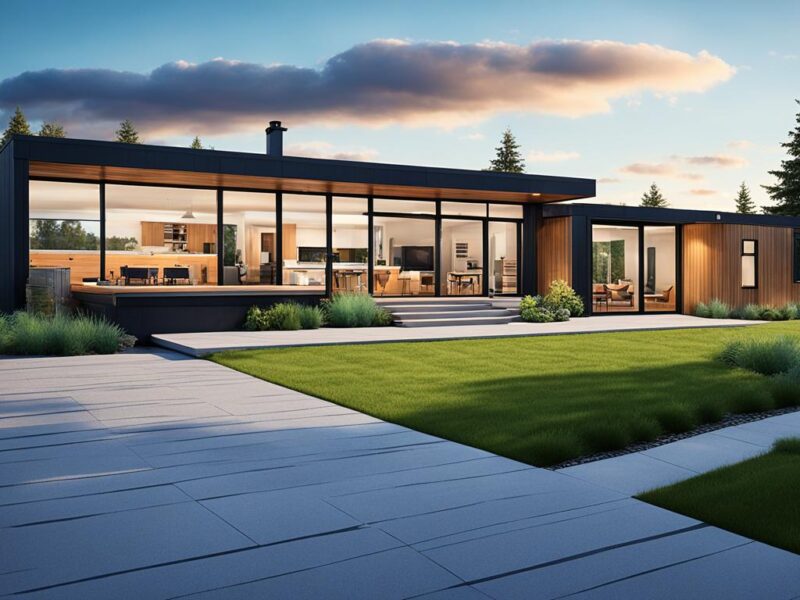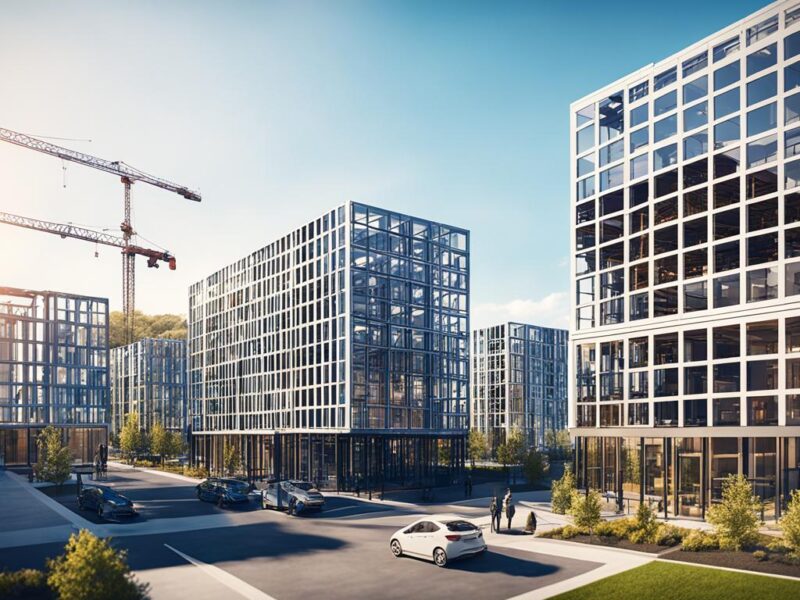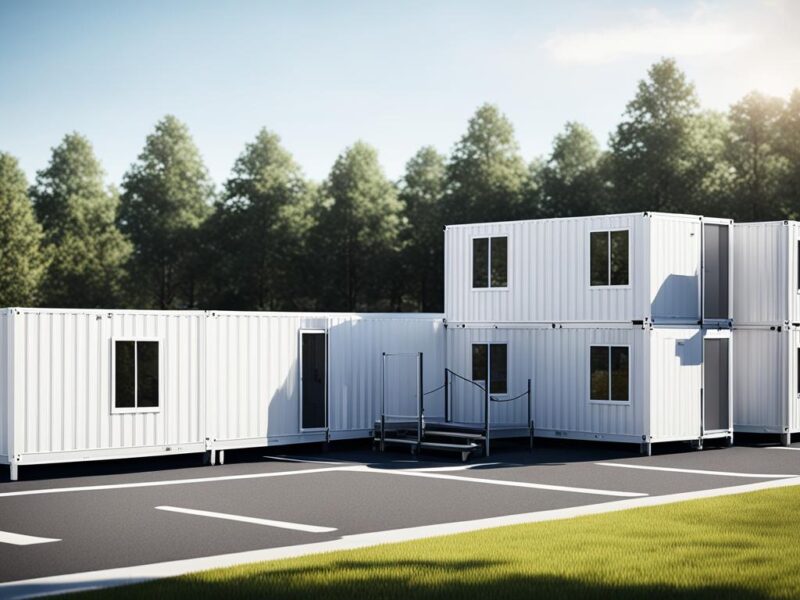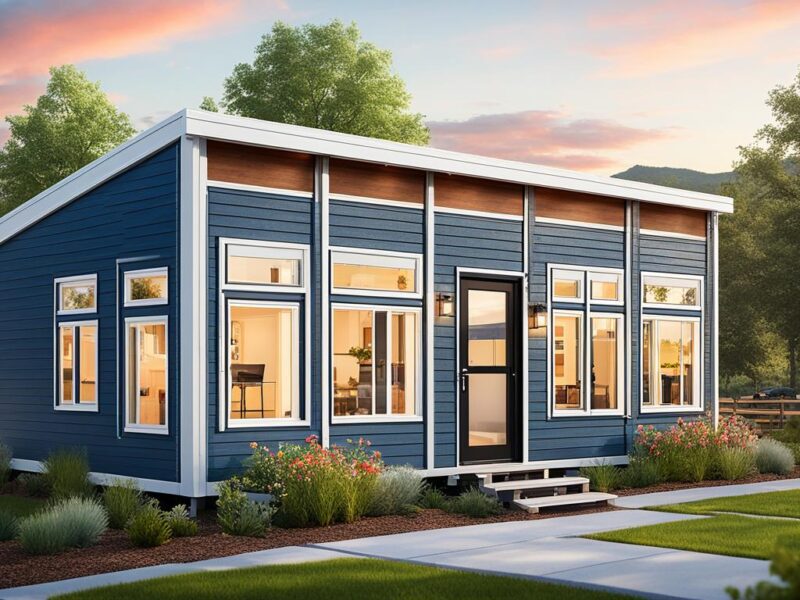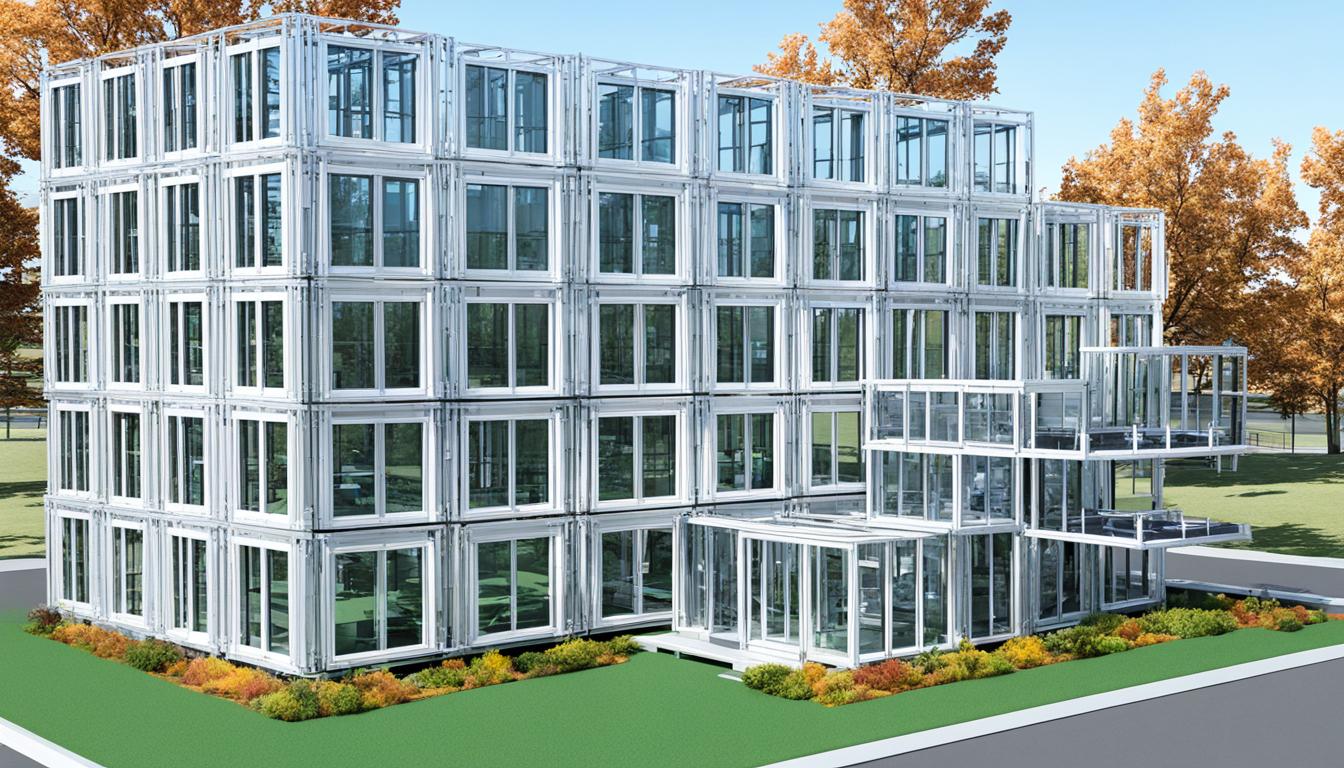
Modular Construction Design Guide for Architects
Welcome to the Modular Construction Design Guide for Architects. In this comprehensive guide, we will explore the world of modular construction and its potential for revolutionizing the architectural industry. Whether you are a seasoned architect or a newcomer to the field, this guide will provide you with valuable insights and practical tips for incorporating modular construction into your designs.
Modular construction is an innovative approach that involves prefabricating components off-site and then assembling them on the project site. This method offers numerous benefits, including shorter construction timelines, improved quality control, and enhanced sustainability. By embracing modular design solutions, architects have the opportunity to enhance their architectural creations while meeting client expectations and adhering to project deadlines.
In this guide, we will delve into the various aspects of modular construction design, exploring the benefits, challenges, and practical considerations. From customized modular units to complete room modules, we will examine the diverse design solutions that modular construction offers, showcasing their innovative and sustainable features. Additionally, we will discuss the barriers that may arise when implementing modular construction and provide guidance on overcoming them.
Throughout this guide, we will also highlight real-world case studies and current trends in modular construction, showcasing the practical application of this approach in various sectors, such as residential, commercial, and hospitality. By exploring these examples, architects can gain inspiration and insights into how modular construction can be integrated into their own projects.
As the architectural industry continues to evolve, it is essential for architects to stay informed about the latest trends and innovative approaches. Modular construction provides a unique opportunity for architects to enhance their designs, optimize resource usage, and contribute to a more sustainable future. By embracing modular construction, architects can shape the future of the industry and create buildings that are efficient, sustainable, and visually stunning.
Key Takeaways:
- Modular construction is an innovative approach that involves prefabricating components off-site and then assembling them on the project site.
- Modular design solutions offer benefits such as shorter construction timelines, improved quality control, and enhanced sustainability.
- Architects can incorporate modular construction into various sectors, including residential, commercial, and hospitality.
- While modular construction offers numerous benefits, it is essential to be aware of the barriers and considerations that may arise.
- By embracing modular construction, architects can shape the future of the industry and create buildings that are efficient, sustainable, and visually stunning.
The Modular Approach in Detail
The modular approach in construction offers a range of design solutions and brings together the integration of design, manufacturing, and construction processes. Architects can harness the power of modular construction to create innovative and sustainable designs that meet the evolving needs of the industry.
One of the key advantages of modular construction is the ability to create customized modular units. These units can be tailored to meet specific design requirements, providing architects with flexibility and creative freedom. Whether it’s a residential building or a commercial space, modular design solutions offer endless possibilities.
An exciting aspect of modular construction is the use of complete room modules. These modules are pre-fabricated off-site and then assembled on-site, reducing construction time and allowing for greater precision in design. With complete room modules, architects can achieve consistency in quality and aesthetics across the project.
“Modular design allows architects to think beyond traditional construction methods and explore new possibilities in creating spaces that are truly unique and sustainable.”
In addition to its design versatility, modular construction is also a sustainable solution. It significantly reduces waste by optimizing resource usage during the manufacturing process. Furthermore, by minimizing on-site construction activities, modular construction helps improve worker safety and mitigate environmental impact.
To highlight the innovative and sustainable aspects of modular design, consider the following:
- Reduced waste: With off-site manufacturing, modular construction drastically reduces construction waste and promotes a more sustainable building process.
- Optimized resource usage: The controlled factory environment of modular construction allows for efficient use of materials, minimizing the impact on natural resources.
- Improved worker safety: By shifting construction activities off-site, modular construction reduces the risks associated with on-site work, ensuring a safer work environment for workers.
By embracing modular design solutions, architects can push the boundaries of innovation while creating sustainable buildings that meet the needs of today and tomorrow.
Next Section: Benefits of Modular Construction
Benefits of Modular Construction
Modular construction offers numerous benefits for architects and project teams. By embracing this innovative approach, architects can enhance architectural design while enjoying the advantages it brings. Let’s explore the key benefits of modular construction:
1. Shorter Construction Timelines
One of the significant advantages of modular construction is its ability to expedite the construction process. With prefabricated components being manufactured off-site, construction timelines are significantly reduced compared to traditional construction methods. This not only saves time but also allows for faster occupancy and quicker return on investment.
2. Improved Quality Control
Modular construction provides an improved level of quality control compared to on-site construction. The controlled factory environment ensures consistent production standards and precise measurements. Additionally, off-site fabrication minimizes the risks of weather-related damage or on-site errors, resulting in higher quality finished projects.
3. Enhanced Sustainability
Modular construction aligns well with sustainable building practices. The process promotes resource efficiency by reducing material waste, optimizing energy consumption, and minimizing environmental impact. Moreover, the ability to repurpose and relocate modular units further enhances sustainability and reduces the carbon footprint of construction projects.
4. Greater Creativity and Adaptability
Architects can unleash their creativity and explore innovative design possibilities with modular construction. The flexibility of modular units allows for adaptability and scalability, making it easier to modify and expand buildings as needed. From unique architectural concepts to versatile floor plans, modular construction provides endless opportunities for architectural design exploration.
With these benefits in mind, it’s clear that modular construction offers architects and project teams a game-changing approach to construction. The next section will delve into the practical application of modular construction, showcasing its impact in real-world projects.
| Benefit | Description |
|---|---|
| Shorter Construction Timelines | Modular construction reduces construction timelines, enabling faster occupancy and accelerated return on investment. |
| Improved Quality Control | Modular construction ensures consistent production standards, higher quality finished projects, and minimized on-site errors. |
| Enhanced Sustainability | Modular construction promotes resource efficiency, reduces material waste, and decreases the carbon footprint of construction projects. |
| Greater Creativity and Adaptability | Modular construction allows for innovative design possibilities, adaptability, and scalability in architectural projects. |
The Modular Approach in Practice
When it comes to architecture, modular construction has been making significant waves in recent years. This section explores the practical application of modular construction in the architectural industry, showcasing real-world case studies and discussing current trends in modular construction. These examples demonstrate how architects can harness the power of modular construction to create stunning designs across various sectors, including residential, commercial, and hospitality.
Modular Construction in Residential Projects
Residential architecture has embraced the modular approach, revolutionizing the way homes are built. From single-family houses to multi-unit developments, architects are utilizing modular components to expedite construction timelines, increase energy efficiency, and ensure high-quality craftsmanship. The ability to prefabricate modules off-site allows for reduced disruptions in residential areas and greater control over the construction process.
Modular Construction in Commercial Projects
The commercial sector has also seen a surge in the adoption of modular construction techniques. Architects are leveraging the versatility and efficiency of modular components to create office spaces, retail establishments, and educational facilities. Modular construction enables faster occupancy, minimizing downtime for businesses. Additionally, the flexibility of modular design allows for scalability, meeting the changing needs of commercial clients.
Modular Construction in Hospitality Projects
The hospitality industry has recognized the benefits of modular construction in delivering exceptional guest experiences. From hotels to resorts, architects are incorporating modular components to enhance efficiency and sustainability. Modular construction allows for rapid construction of room units, ensuring faster project completion. Moreover, the quality control measures inherent in factory production result in superior finishes and amenities for guests.
Current Trends in Modular Construction
Architects involved in modular construction are at the forefront of innovative design and construction practices. Some key trends in modular construction include:
- Sustainable Design: Modular construction lends itself well to sustainable design principles, with a focus on energy efficiency, waste reduction, and the use of eco-friendly materials.
- Customization: Architects can take advantage of modular construction’s flexibility to tailor design solutions to meet clients’ specific requirements, achieving both functionality and aesthetic appeal.
- Smart Home Integration: Modular construction allows for seamless integration of smart home technology, enhancing the living experience for homeowners.
- High-rise Modularity: As modular construction techniques advance, architects are exploring the possibilities of utilizing modules in high-rise buildings, challenging traditional construction methods.
In summary, modular construction is not only a trend but a transformative approach that architects can leverage to create efficient, sustainable, and visually striking designs. By tapping into the potential of modular construction, architects can push the boundaries of what’s possible in the field of architecture.
| Benefits | Residential | Commercial | Hospitality |
|---|---|---|---|
| Shorter Construction Timelines | ✓ | ✓ | ✓ |
| Improved Quality Control | ✓ | ✓ | ✓ |
| Enhanced Sustainability | ✓ | ✓ | ✓ |
| Customizability | ✓ | ✓ | ✓ |
| Cost Efficiency | ✓ | ✓ | ✓ |
Barriers and Considerations for Modular Construction
While modular construction offers numerous benefits, it is important to be aware of the potential barriers and considerations that may arise during implementation. Addressing these challenges proactively can help ensure the successful integration of modular construction into architectural projects.
Early Decision-Making and Coordination
One of the key considerations for modular construction is the need for early decision-making and coordination among project stakeholders. Since modular components are prefabricated off-site, critical decisions regarding design, materials, and specifications must be made early in the process. Any changes made later in the project can lead to delays and additional costs.
“The success of modular construction heavily relies on early engagement and collaboration among architects, contractors, and developers. By involving all stakeholders from the beginning, potential conflicts and disruptions can be minimized, ensuring a smoother construction process.”
Transportation and Site Accessibility
Transporting modular units to the project site requires careful planning and consideration of site accessibility. Factors such as road conditions, overhead clearances, and weight restrictions must be evaluated to ensure smooth delivery and installation. Challenges related to transportation logistics can impact project timelines and budgets.
Regulatory Compliance and Permitting
Modular construction often necessitates compliance with local building codes and regulations. Acquiring the necessary permits and approvals for modular projects may require additional time and effort. Architects must work closely with regulatory authorities to ensure that the designs and construction methods align with the applicable requirements.
Quality Control and Coordination
Maintaining consistent quality control throughout the modular construction process can be challenging due to the involvement of various manufacturers and suppliers. Architects must collaborate closely with modular manufacturers to ensure that quality standards are met and components are seamlessly integrated at the project site.
“By developing strong relationships with trusted modular manufacturers and conducting thorough quality checks, architects can mitigate the inherent risks associated with multiple suppliers and ensure the delivery of quality and durable modular components.”
Financial Considerations
While modular construction can offer cost savings in terms of reduced labor and material waste, architects should carefully evaluate the financial considerations associated with this approach. Upfront costs for design modifications, engineering, and manufacturing may be higher compared to traditional construction methods. However, the long-term benefits and efficiencies can outweigh these initial investments.
| Barriers to Modular Construction | Considerations for Modular Construction |
|---|---|
| Early decision-making and coordination among stakeholders. | Transportation logistics and site accessibility. |
| Regulatory compliance and permitting. | Quality control and coordination between manufacturers. |
| Financial considerations for upfront costs. |
Overcoming these barriers and carefully considering the associated considerations can help architects successfully implement modular construction in their projects. By leveraging the benefits of this innovative construction method while navigating the challenges, architects can deliver sustainable, efficient, and aesthetically pleasing architectural designs.

Conclusion
In conclusion, modular construction trends in architecture offer architects a transformative opportunity to enhance their designs with efficiency, sustainability, and innovation. By incorporating modular design solutions into their projects, architects can revolutionize the industry and shape the future of construction.
One of the key benefits of modular construction is the ability to achieve shorter construction timelines. By prefabricating components off-site, construction time can be significantly reduced, allowing for quicker project delivery and cost savings.
Furthermore, modular construction enhances quality control measures. With controlled manufacturing processes in a factory setting, the risk of errors and defects is minimized. This results in higher-quality buildings and increased client satisfaction.
Moreover, embracing modular construction supports environmental sustainability efforts. By optimizing resource usage and reducing waste, this approach minimizes the environmental impact of construction projects. Architects can play a crucial role in creating sustainable buildings by choosing modular construction methods.
As modular construction continues to evolve, architects should stay current with the latest trends and advancements in this field. By integrating modular design principles and techniques into their projects, architects can unlock new possibilities for creativity, adaptability, and improved architectural design.
In summary, modular construction not only offers practical benefits, but it also has the potential to enhance architectural design. With its efficiency, sustainability, and ability to inspire innovation, modular construction is paving the way for the future of the architectural industry.




